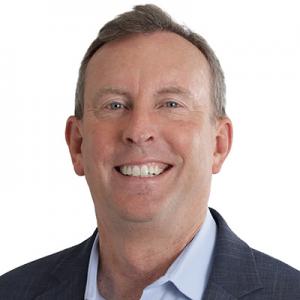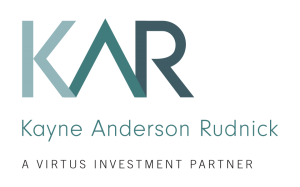
Jon Christensen
Portfolio Manager and Senior Research Analyst
Kayne Anderson Rudnick
KAR portfolio manager Jon Christensen discusses mid-cap equity performance for the second quarter and first half of 2024, stock contributors and detractors in the KAR Mid Cap Core strategy, and expectations for the second half of the year.
Listen Now
Transcript
BEN FALCONE: Hello, this is Ben Falcone, managing director with Kayne Anderson Rudnick, and with me today, I have Jon Christiansen, portfolio manager of the Kayne Anderson Rudnick Mid Cap Core strategy. Welcome, Jon. Jon, market returns were much narrower in the second quarter with the S&P 500® and Russell 1000® Growth up meaningfully while small and mid-caps underperformed. Can you provide our listeners with your perspective on markets as we are at the halfway point of 2024?
JON CHRISTENSEN: Yeah, of course. This has been a fascinating year so far and that markets have reacted differently depending on various niches. First, let's look at the S&P 500, which increased 4.3% in Q2 and 15.3% year to date. This index has been strongly influenced by chip makers and other tech companies that have also added to the surge after being left for dead by many investors.
The Russell Midcap Index, on the other hand, was down 3.3% in Q2 and is tracking up 5% year to date, hugely lagging the S&P 500 and the Russell 1000 Growth, which has increased over 20% year to date. So, you can clearly see where the momentum of the market is trending. So part of the reason for this bifurcation in the markets is the momentum that large caps currently have, but it's still incredibly concentrated, just a very few names. This is where things can get kind of overly focused and myopic in terms of long-term opportunities for investors.
AI has been a buzzword for many of these stocks that have achieved outsized performance. However, what was once the Magnificent Seven continues to erode to a smaller number week by week. Outside of these thematic plays, the rest of the market seems to be oscillating on news of interest rates being higher for longer on one hand and the job market that's showing signs of economic strength and resistance to a hard landing in the economy. But we want everyone here to remember that in the end, we believe these stocks all need to trade on the strength of their financials.
We seek out businesses that, in our view, have a clear competitive moat in industries where the environment is more clearly defined. AI will play a large role in our economy in the future. That is true. But we are waiting for the more secular trends to develop. We have seen these periods where large cap has been in favor, but from our perspective, companies with greater prospects for higher sustained earnings growth over the long term are those smaller entities with substantial competitive moats over the long run, which is where our focus is.
BEN FALCONE: Jon, would you say fundamentals and earnings are driving performance so far during the year, or is it more the change in interest rate expectations, along with AI exuberance?
JON CHRISTENSEN: Yeah, kind of piggybacking on my last answer, it does appear that investors are favoring larger-cap names, in certain sectors, due in part to kind of FOMO, which is, you know, fear of missing out. I'm not saying these companies aren't raising their earnings forecasts, but remember that rich valuations imply a sustained level of this growth, which as we know, becomes more difficult the larger those companies become. So, some of the large-cap outperformance has been fundamentals, but the majority of my opinion is zeitgeist.
Part of the underperformance of small and mid caps has been the overt focus on large caps, but I will also argue that there's a trepidation by many investors to invest in small caps and mid-caps due to the overhang for interest rate cuts that have been anticipated since the beginning of the year and have not come to fruition. This has been that kind of cat and mouse game that the Fed has been playing as it sees inflation data oscillate and job creation remains strong.
So, the bottom line is we are not seeing any deterioration in the fundamentals of our companies as we navigate this market. This gives us confidence that our portfolio should perform as expected over time. We also believe that because interest rates are remaining higher for longer, this should play in our favor as well given the lower debt levels our companies have on their balance sheets.
BEN FALCONE: Jon, can you discuss a few of the portfolio holdings that were key contributors and detractors to performance for the second quarter of 2024?
JON CHRISTENSEN: In terms of contributors to the portfolio in the quarter, they were Monolithic Power, HEICO, Exponent, Verisk Analytics, and Lennox International.
Lennox is a provider of HVAC units for commercial and residential customers. The shares outperformed last quarter as the company has taken steps to acquire market share through internal initiatives, and it is seeing lower inventory to stocking that we believe should lead to volume growth.
In terms of those names in the portfolio that detracted the most, they were Pool Corp, West Pharmaceutical, Lamb Weston, Align Technology, and Nordson.
Align Technology is a relatively new purchase for us. They produce the Invisalign clear aligners utilized by the dental industry. The stock has been weak due to concerns over the overall economic sentiment and consumers' willingness to pay for aligners given the premium cost. The current interest rate environment is not helping matters. However, in the long term, we really believe these products provide consumers with a more pleasant experience versus traditional wire braces, and as more dentists adopt the procedure, we believe this should become the standard of care.
BEN FALCONE: Jon, with the Fed seemingly on hold, do you think we will see more of the same in terms of market performance in the back half of the year, and can small and mid-caps do well if everything stays status quo?
JON CHRISTENSEN: It’s really hard to say that things will stay the same given the future is uncertain, and we have an election in the second half of this year, so anything is possible to be blunt. What I will say is that trends are called trends for a reason and that they do not last forever. We have periods of time in the history of the U.S. stock market where large caps have outperformed small caps and vice versa. Tech has been hot. Anybody remember the dot-com bubble? And energy has had its moments as well, thanks recently to Russia.
So, these events get headlines but as bottom-up investors, we cannot make our decisions based on short-term issues. We, as investors, think longer term and try not to avoid but not focus on these short-term trends that are outside of our investment philosophy and process. We are focused on the fundamentals of a company's business, and sometimes that gets rewarded right away. Other times it takes patience from the market to recognize this. This is a period we are working through now.
This may seem easy and achievable in plain terms, but the execution and durability of the strategy is not that simple. We look for businesses that can outgrow their industry through building and keeping a competitive moat that allows these businesses to have robust margins, as well as a solid free cash flow through their low capital-intense models that allow us to self-finance their future investments. We strive to find companies that can enact this strategy in good times, but more importantly, during more challenging economic periods, where these stocks can mitigate their downside and enhance their ability to outperform our benchmark over multiple economic cycles.
As we move along in 2024, the markets seem to be absorbing the ups and downs of inflation, the Fed, and recent geopolitical events. We also have an election year ahead of us. This does create uncertainty in terms of entry points for the equity markets. This has been well illustrated in those ups and downs we've been seeing in the markets this year.
So, given these uncertainties and volatility, what does one do? Our goal, again, is to find solid companies with business models that can react and persevere in reaction to this volatility. We also make our investment decisions based on fundamentals and not where the political winds are blowing. But our mandate is clear and consistent as we focus on high-quality businesses that we believe should outgrow their markets over the long term and take advantage of this market volatility.
BEN FALCONE: Jon, as always, thanks for taking the time to provide your insight to our KayneCast listeners.
*Pool Corp, West Pharmaceutical, Lamb Weston, Align Technology, and Nordson were the five largest detractors in the KAR Mid Cap Core SMA. Pool Corp, Lamb Weston, West Pharmaceutical, Align Technology, and Cooper Cos. were the five largest detractors in the Virtus KAR Mid-Cap Core Fund, and Nordson Was #6.
This information is being provided by Kayne Anderson Rudnick Investment Management, LLC (“KAR”) for illustrative purposes only. Information contained in this material is not intended by KAR to be interpreted as investment advice, a recommendation or solicitation to purchase securities, or a recommendation for a particular course of action and has not been updated since the date of the material, and KAR does not undertake to update the information presented should it change. This information is based on KAR’s opinions at the time of the recording of this material and are subject to change based on market activity. There is no guarantee that any forecasts made will come to pass. KAR makes no warranty as to the accuracy or reliability of the information contained herein.
Investing is subject to risk, including the risk of possible loss of principal.
Past performance is no guarantee of future results.
3723078
